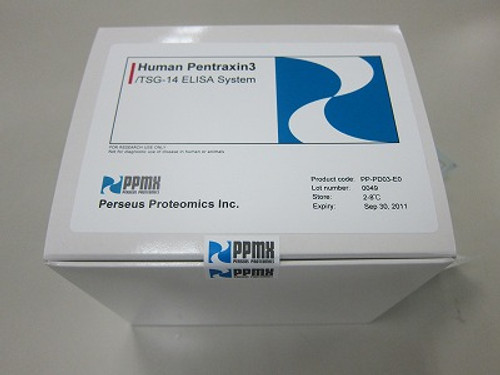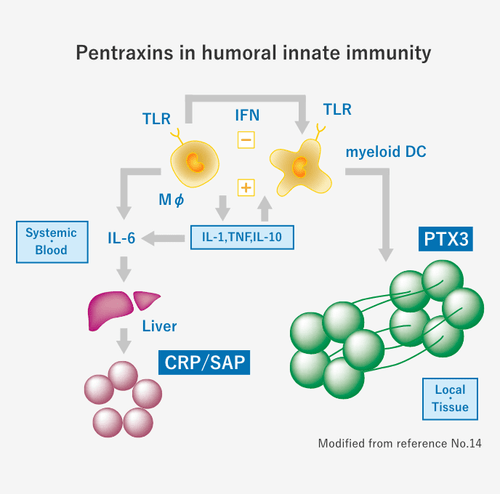Pentraxin 3 / TSG-14/PTX3 ELISA System
Perseus Proteomics
- Catalog No.:
- PPX-PP-PD03-E0
- Shipping:
- Calculated at Checkout
Immunosorbent assay for the quantitative measurement of human Pentraxin3(PTX3) in plasma and serum-free cell culture supernatant Supplementary: Sandwich
Applicable Sample: Plasma, culture supernatan
Other: Pentraxins are a superfamily of conserved proteins characterized by the pentraxin domain (1-6). C-reactive protein (CRP) and serum amyloid protein (SAP) are recogni
PTX3 is classified as a Long Pentraxin in the Pentraxin family.
CRP (C-reactive protein) belonging to the Short Pentraxin of the Pentraxin family is known as an arteriosclerosis marker, but since it is produced in the liver and also increases in infections, it shows not only vascular inflammation but also systemic inflammatory reaction. It is presumed that there is.
In contrast to CRP, PTX3 is stimulated by IL-1 and TNF and is produced directly from vascular endothelial cells, vascular smooth muscle, neutrophils, and macrophages closely related to arteriosclerosis.
PTX3 has been shown to be associated with human heart disease, and it has been reported that it may be a marker that can predict the prognosis of acute myocardial infarction and that PTX3 concentration increases at an early stage in patients with myocardial infarction. In recent years, it has been reported that it has a function of suppressing angiopathy in sepsis, early detection of pulmonary hypertension, and its relationship with bone metabolism.
Citations
Lusis AJ. Nature. 2000 Sep 14; 407 (6801): 233-41. (PMID: 11001066)
Baumann H, et al. Immunol Today. 1994 Feb; 15 (2): 74-80. (PMID: 7512342)
Steel DM, et al. Immunol Today. 1994 Feb; 15 (2): 81-8. (PMID: 8155266)
Lee GW, et al. J Immunol. 1994 Oct 15; 153 (8): 3700-7. (PMID: 7523502)
Bottazzi B, et al. J Biol Chem. 1997 Dec 26; 272 (52): 32817-23. (PMID: 9407058)
Introna M, et al. Blood. 1996 Mar 1; 87 (5): 1862-72. (PMID: 8634434)
Basile A, et al. J Biol Chem. 1997 Mar 28; 272 (13): 8172-8. (PMID: 9079634)
Jaillon S, et al. J Exp Med. 2007 Apr 16; 204 (4): 793-804. Epub 2007 Mar 26. (PMID: 17389238)
Latini R, et al. Circulation. 2004 Oct 19; 110 (16): 2349-54. (PMID: 15477419)
Peri G, et al. Circulation. 2000 Aug 8; 102 (6): 636-41. (PMID: 10931803)
Daigo K, et al. Sci Signal. 2014 Sep 16; 7 (343): ra88. (PMID: 25227610)
Shirai Y, et al. Arthritis Rheumatol. 2015 Feb; 67 (2): 498-507. (PMID: 25385504)
Scimeca M, et al. Cell Death Dis. 2017 Oct 12; 8 (10): e3125. (PMID: 29022895)
Garlanda C, et al. Annu Rev Immunol. 2005; 23: 337-66. (PMID: 15771574)
Inoue K, et al. Arterioscler Thromb Vasc Biol. 2007 Jan; 27 (1): 161-7. (PMID: 17095712)
| Product Specifications | |
| Reactivity | Human |
| Documents & Links for Pentraxin 3 / TSG-14/PTX3 ELISA System | |
| Datasheet | ppx-pp-pd03-e0_pentraxin-3--tsg-14ptx3-elisa-system_datasheet.pdf |
| Documents & Links for Pentraxin 3 / TSG-14/PTX3 ELISA System | |
| Datasheet | ppx-pp-pd03-e0_pentraxin-3--tsg-14ptx3-elisa-system_datasheet.pdf |
| Citations for Pentraxin 3 / TSG-14/PTX3 ELISA System – 1 Found |
| Osorio-Conles, O; Guitart, M; Chacón, M R; Maymo-Masip, E; Moreno-Navarrete, J M; Montori-Grau, M; Näf, S; Fernandez-Real, J M; Vendrell, J; Gómez-Foix, A M. Plasma PTX3 protein levels inversely correlate with insulin secretion and obesity, whereas visceral adipose tissue PTX3 gene expression is increased in obesity. American Journal Of Physiology. Endocrinology And Metabolism. 2011;301(6):E1254-61. PubMed |



